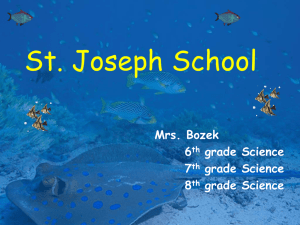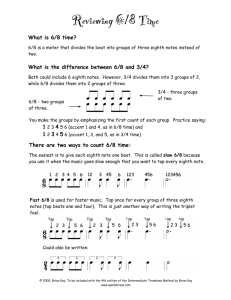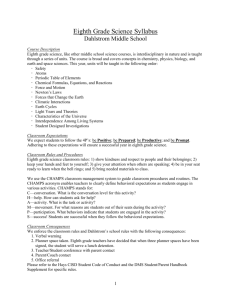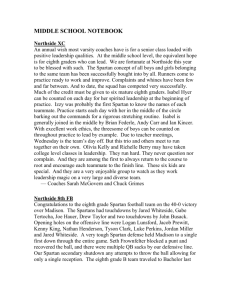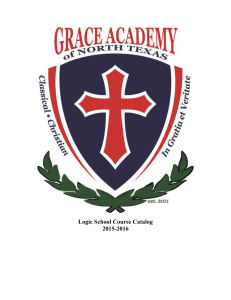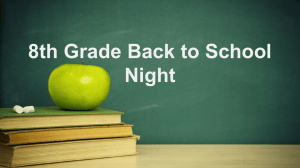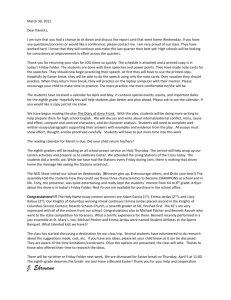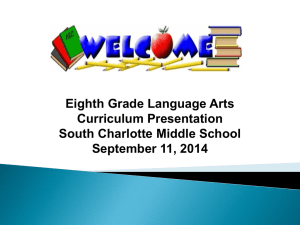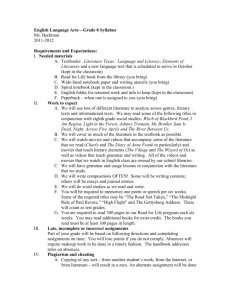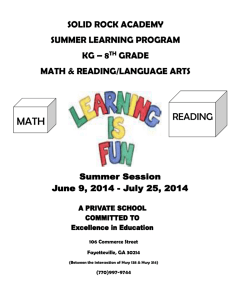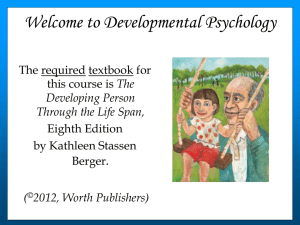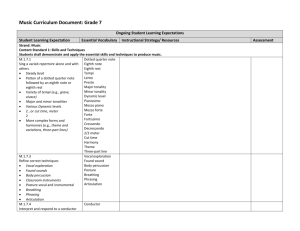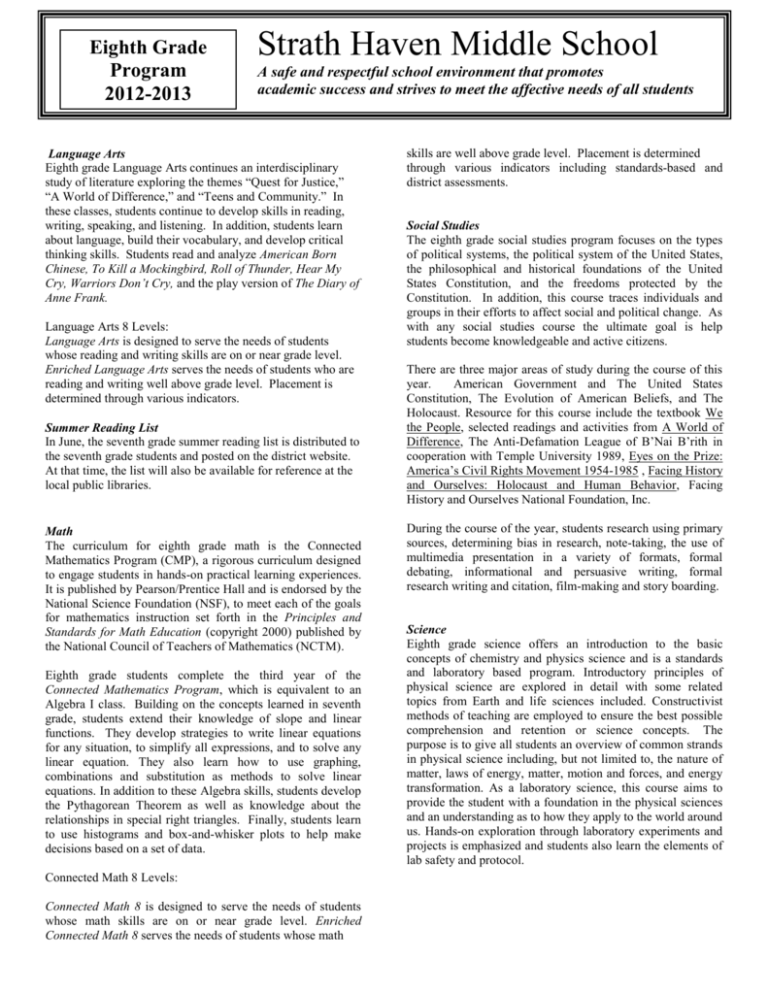
Eighth Grade
Program
2012-2013
Strath Haven Middle School
A safe and respectful school environment that promotes
academic success and strives to meet the affective needs of all students
Language Arts
Eighth grade Language Arts continues an interdisciplinary
study of literature exploring the themes “Quest for Justice,”
“A World of Difference,” and “Teens and Community.” In
these classes, students continue to develop skills in reading,
writing, speaking, and listening. In addition, students learn
about language, build their vocabulary, and develop critical
thinking skills. Students read and analyze American Born
Chinese, To Kill a Mockingbird, Roll of Thunder, Hear My
Cry, Warriors Don’t Cry, and the play version of The Diary of
Anne Frank.
Language Arts 8 Levels:
Language Arts is designed to serve the needs of students
whose reading and writing skills are on or near grade level.
Enriched Language Arts serves the needs of students who are
reading and writing well above grade level. Placement is
determined through various indicators.
Summer Reading List
In June, the seventh grade summer reading list is distributed to
the seventh grade students and posted on the district website.
At that time, the list will also be available for reference at the
local public libraries.
Math
The curriculum for eighth grade math is the Connected
Mathematics Program (CMP), a rigorous curriculum designed
to engage students in hands-on practical learning experiences.
It is published by Pearson/Prentice Hall and is endorsed by the
National Science Foundation (NSF), to meet each of the goals
for mathematics instruction set forth in the Principles and
Standards for Math Education (copyright 2000) published by
the National Council of Teachers of Mathematics (NCTM).
Eighth grade students complete the third year of the
Connected Mathematics Program, which is equivalent to an
Algebra I class. Building on the concepts learned in seventh
grade, students extend their knowledge of slope and linear
functions. They develop strategies to write linear equations
for any situation, to simplify all expressions, and to solve any
linear equation. They also learn how to use graphing,
combinations and substitution as methods to solve linear
equations. In addition to these Algebra skills, students develop
the Pythagorean Theorem as well as knowledge about the
relationships in special right triangles. Finally, students learn
to use histograms and box-and-whisker plots to help make
decisions based on a set of data.
Connected Math 8 Levels:
Connected Math 8 is designed to serve the needs of students
whose math skills are on or near grade level. Enriched
Connected Math 8 serves the needs of students whose math
skills are well above grade level. Placement is determined
through various indicators including standards-based and
district assessments.
Social Studies
The eighth grade social studies program focuses on the types
of political systems, the political system of the United States,
the philosophical and historical foundations of the United
States Constitution, and the freedoms protected by the
Constitution. In addition, this course traces individuals and
groups in their efforts to affect social and political change. As
with any social studies course the ultimate goal is help
students become knowledgeable and active citizens.
There are three major areas of study during the course of this
year.
American Government and The United States
Constitution, The Evolution of American Beliefs, and The
Holocaust. Resource for this course include the textbook We
the People, selected readings and activities from A World of
Difference, The Anti-Defamation League of B’Nai B’rith in
cooperation with Temple University 1989, Eyes on the Prize:
America’s Civil Rights Movement 1954-1985 , Facing History
and Ourselves: Holocaust and Human Behavior, Facing
History and Ourselves National Foundation, Inc.
During the course of the year, students research using primary
sources, determining bias in research, note-taking, the use of
multimedia presentation in a variety of formats, formal
debating, informational and persuasive writing, formal
research writing and citation, film-making and story boarding.
Science
Eighth grade science offers an introduction to the basic
concepts of chemistry and physics science and is a standards
and laboratory based program. Introductory principles of
physical science are explored in detail with some related
topics from Earth and life sciences included. Constructivist
methods of teaching are employed to ensure the best possible
comprehension and retention or science concepts. The
purpose is to give all students an overview of common strands
in physical science including, but not limited to, the nature of
matter, laws of energy, matter, motion and forces, and energy
transformation. As a laboratory science, this course aims to
provide the student with a foundation in the physical sciences
and an understanding as to how they apply to the world around
us. Hands-on exploration through laboratory experiments and
projects is emphasized and students also learn the elements of
lab safety and protocol.
Foreign Language
Spanish/German/French/Mandarin Chinese
The study of foreign languages in the middle school addresses
the four language modalities of listening, speaking, reading
and writing for all target languages. The geography and
culture of the places where the target languages are spoken are
included in the first three years of study as well. Students
engage in simple conversations, cultural simulations, and
reading and writing that mirror daily life activities of the target
language. Students demonstrate auditory comprehension and
speaking ability through a variety of measures such as
dialogues and open-ended question and answer sessions.
Assessments are both written and oral. The goal is to promote
communication in the target language in a variety of ways.
The world language curriculum is cumulative and each
successive year builds through review and expansion of the
material covered in previous years. By the end of the 7 th and
8th grades, the students practice the four language modalities
through some or all of the thematic units of home and family,
free-time activities, school, clothing, shopping, food, around
town and places of interest, and daily routines.
Cultures I and II
Cultures course is taken by students who have not had a 6 th
and/or 7th grade foreign language experience. In this course,
students develop an understanding of culture through a
comparison of their own culture with those of other peoples.
They discover the features of culture and study the effects of
geography and biodiversity on culture, as well as historical
reasons for cultural differences. In year one of Cultures,
students focus on the study of various countries around the
world and their customs. In year two, students expand this
study of culture in an assortment of thematic units such as
communication, relationships, food, and family. They explore
the cultures through the mediums of readings, documentaries,
and exploration of visual and auditory arts. Students gain
insights and reflect through journal writing.
QUARTERLY COURSES( 9 weeks):
Art
The curriculum for 8th grade art comprises three areas of
concentration: Traditional Fine Arts, Interdisciplinary Arts,
and Cultural Arts. The course is designed this way in order to
provide students with the broadest possible exposure to the
world of art. Throughout the nine weeks, students will study
art history, indigenous and cultural art, and the basic principles
of fine arts design all through two-dimensional and threedimensional works such as drawing, painting, collage,
printmaking and mixed-media.
Music
8th grade general music is a culmination of general music
grades K-7. These students will spend their time in the
keyboard technology lab learning how to play the piano,
composing music, and performing for the class. Students will
use a software notation program, Finale, to compose and
arrange music. Students will discover practical applications of
music and technology into their everyday lives.
Technology Education
The technology education program allows students to gain a
greater understanding of technology by utilizing the
technological design process to solve open-ended problems in
a materials laboratory. This process includes designing,
prototyping, refining, and producing a product. During this
quarter-long session, students learn how to utilize basic hand
tools and machines ranging from a hammer and screwdriver to
a bandsaw and disc sander. The students will also receive an
introduction to CAD/CAM programming where they will use
software to design a solution to a problem and later setup a
computerized machine to produce their individual design
and/or parts.
Family and Consumer Science
Eighth Grade Family and Consumer Sciences is a course
designed to prepare students for independent living while
exploring consumer choices. The course focuses on the
development of knowledge and skills in the areas of clothing
and textiles, consumer sciences, nutrition and wellness, and
resource management. As part of the textiles unit, students are
introduced to basic skills in fabric repair and safe use of the
sewing machine. Students construct textiles projects in the
sewing lab utilizing a standard sewing machine and
personalize the product with a computer-assisted embroidery
machine. Students also learn to assess clothing for fiber
content, proper care, and quality construction.
SEMESTER COURSES (18 weeks):
Physical Education/Health (18-week Semester Course)
This two component class includes physical education and
health. In physical education, students are reacquainted with
sports and fitness concepts from earlier grades, as well as
introduced to new ones in eighth grade. These concepts are
explored through exercise, fitness evaluations, and play, with
activities including invasion games, non-traditional games,
team building activities, net games, and aerobic and strength
training routines. The health curriculum focuses on physical
and social health topics starting with human body systems,
relationships, teenage dating & sexuality, and HIV/STD
prevention.
Computer Science (18-week Semester Course)
In 8th grade Computer Science class, students receive
instruction on Technology Safety, intro to programming and
intro to html. Through Learning to Program with Alice,
students will develop programming skills. Later in the
semester, students are introduced to html through the creation
of their 8th grade portfolio project. Students explore web
design software such as Flash, Photoshop and Dreamweaver.
They are expected to implement proper web design techniques
in their final project. By working closely with students and
their subject teachers, these elements are integrated through an
interdisciplinary approach.
ADDITIONAL PROGRAMS:
Performing Music Ensembles
Opportunities to perform in music ensembles at Strath Haven
Middle School are abundant and include band, chorus, and
orchestra. Rehearsal times are from 7:00 a.m. – 7:50 a.m. The
orchestra meets once each week, while the band and chorus
rotate their rehearsals. Students and parents receive monthly
calendars and schedules. Jazz band and other small ensembles
are selected by audition in the fall, and they rehearse two days
each week after school. Group music lessons are offered once
each week on a rotating pull-out schedule. Students are
encouraged to make music performance a part of their school
lives. In the past few years, over 70% of the total seventh
grade has performed in one or more of the music ensembles
offered.
Community Service Project
Every eighth grade student is expected to complete a 4-6 hour
community service project during the course of the year.
After performing the service, each student completes a 1-2
page paper on the experience. We provide opportunities for
the students to complete this project during the year. The
eighth grade at SHMS has well-earned reputation of
compassion and altruism. In the past the students provided
solar panels for a Gambian hospital in need, aided over 150
Darfur refugee families, and last year over 140 8 th grade
students ran a 5K raising money for Back On My Feet.
Guidance
At Strath Haven Middle School, a guidance counselor is
assigned to each grade level. The counselor begins working
with the sixth graders during their first year in the middle
school and stays with them throughout the end of their
freshman year in high school. This plan enables the counselor
to follow the development of each student during his or her
middle school years, while establishing a working relationship
with both students and parents. This approach also helps ease
the transition to high school. Counselors inform teachers of
the needs of each student, acting as a consultant to students,
parents, teachers, and administrators. In addition, counselors
provide individual counseling, developmental counseling
groups, and crisis intervention. The guidance counselor is the
liaison between student and teacher and between home and
school.
.

